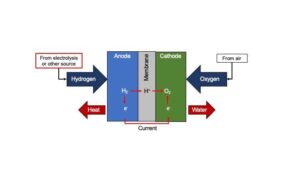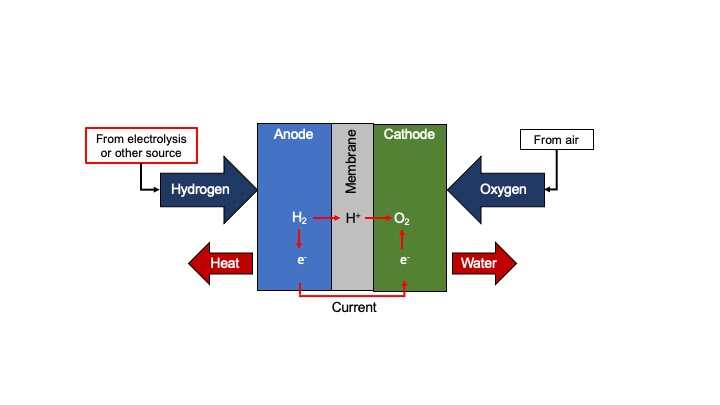5 Examples of Stored Energy Explained
Examples of stored energy are; organic bioenergy, fossil fuel energy, energy in fuel cells and batteries, nuclear energy in radioisotopes, and hydro energy in stationary water bodies.
This article discusses the examples of stored energy, as follows;
1). Organic Bioenergy (as one of the Examples of Stored Energy)
Organic bioenergy is energy that is stored in biomass, as a result of biological processes that govern food chains and energy pyramids in all natural ecosystems.
Also known as biomass energy, it is stored in organic matter which comprises the parts of living organisms. Organic bioenergy falls under chemical potential energy, which is one of the three main types of stored energy.
It can be deduced from the above that biomass serves as an energy storage medium for bioenergy. This is evident in the use of biomass as an energy resource in biomass-power plants and biorefineries.
Biomass is not an intermittent energy source, in terms of its supply, since it is constantly being regenerated in nature. On the contrary, it can be described as a renewable energy source.
Ultimately, the type of energy stored in biomass is solar energy; which is captured by plants in the process of photosynthesis [3]. This implies that organic bioenergy is the converted, chemical form of solar energy that has been stored in organic materials.
The use of organic bioenergy can be achieved either by burning biomass (such as wood and organic waste) directly to produce thermal energy for heating or electricity generation.
Biomass may also be processed to produce biofuel; which could be liquid form as in biodiesel, or gaseous as in biogas.
These fuels can be derived from landfills where they are produced during the biodegradation of organic waste. They may also be derived through any of various biomass conversion or waste-to-energy processes like anaerobic digestion, pyrolysis or gasification.
Biofuels are easier to store than raw biomass, and can be used as an alternative to fossil fuels for several applications [5].
2). Fossil Fuel Energy
Fossil fuel energy is a variant of organic bioenergy (which is chemical potential energy) that is stored in fossil fuels like coal, natural gas and petroleum.
Energy is stored in fossil fuels by the long-term burial and thermal alteration of organic matter, in the absence of significant amount of oxygen [4]. The energy is stored in complex chemical bonds that are formed between carbon, hydrogen and oxygen atoms in the resulting fossil fuels.
Like organic bioenergy in animal and plant matter, fossil fuel energy is derived ultimately from the Sun through photosynthesis.
The formation of fossil fuels can therefore be viewed as a process of energy conservation, because it prevents the release of bioenergy to the environment, as occurs during biodegradation.
Biochemical processes like biodegradation and combustion, cause stored energy to be released from fossil fuels. This energy can then be used to power electric generators and fossil fuel-fired power plants, to generate electricity.
Fossil fuels are the most-used energy resource in commercial, domestic and industrial systems, because they have high energy density compared to alternatives. However, thee fuels are non-renewable, and can have unfavorable environmental impacts such as oil spill, air pollution and global warming, when used.
Fossil fuel can be stored in tankers under suitable temperature and pressure, with adequate maintenance to prevent leakage, explosion and fire hazards.
3). Energy in Fuel Cells and Batteries (as one of the Examples of Stored Energy)
Fuel cells and batteries are not energy resources, but rather manmade energy storage systems. The energy in thee devices represent classic examples of stored energy in manmade systems.
The main difference between a fuel cell and a battery is based on working principle; where fuel cells work by converting stored chemical energy in available fuel, while battery stores electricity by temporarily converting it to chemical energy.
Fuel cells and batteries are very similar in that they both operate on electrochemical principles.
Energy stored in a fuel cell is chemical potential energy, which is contained in liquid hydrogen or any other suitable energy resource. To release this stored energy, electrochemical reactions must occur in the fuel cell, so that ionic polarization of the electrolytic fuel can cause electric charges to flow.
Energy stored in a battery is chemical potential energy, derived by converting electric charges through electrochemical ion-accumulation. The electric charges are stored in the battery when it is connected to a source.
Batteries release their stored energy to a load by converting the stored chemical energy back to electricity through electrochemical polarization [2].
Battery and fuel cell technologies have played (and will play) an innovative role in the energy transition, and in energy development as a whole. Their relevance can be observed in hybrid cars, electric vehicles, and distributed energy resource management systems (DERMS).

Examples of Stored Energy: Energy in Fuel Cells and Batteries (Credit: Emma Ambrogi 2021 .CC BY-SA 4.0.)
4). Nuclear Energy in Radioisotopes
The type of energy that can be found in radioactive substances is chemical potential energy, which is also referred to as nuclear energy because it is stored in atomic nuclei.
Note that the key difference between nuclear energy and other forms of chemical potential energy lies in the specific location of energy storage. Nuclear energy is stored by the dynamics of electrostatic forces that keep protons and neutrons in their atomic orbits; while conventional chemical potential energy is stored only in the chemical bonds between atoms.
Radioisotopes release energy when they are subjected to radioactive decay through spontaneous or controlled chemical reactions.
To use radioisotopes in nuclear energy development, the release of energy from these materials through radioactive reactions, must be controlled in a definite thermodynamic system.
This thermodynamic system is the nuclear reactor, which forms a primary part of a nuclear power plant, and controls radioactive reactions in its core through neutron bombardment and cooling mechanisms.
Uranium and Plutonium are prominent examples of radioisotopes that contain nuclear energy.
The importance of this form of stored energy comes from the fact that nuclear fuels have high energy density, and although they are non-renewable, they are also clean energy resources with minimal environmental impact and no emissions.
The only problems of nuclear energy arise from unsustainable methods of nuclear fuel mining, processing, and nuclear waste management.
5). Hydro Energy of Stationary Water Bodies (as one of the Examples of Stored Energy)
The energy stored in a hydroelectric power station is hydraulic potential energy, which is one of the three main types of stored energy. It can also be described as potential hydro energy, because it can occur in water by virtue of its stationary state or position.
Hydro energy is stored by the interaction of water molecules with the Earth's gravitational and geomagnetic fields. These fields exert their influence very strongly when large volumes of dense fluids have been accumulated within the boundaries of a system.
The storage of hydro energy is exploited in hydropower, wave energy and tidal energy systems.
For hydro energy to be stored, water or any other suitable fluid, must be accumulated in an enclosure such as a water dam-reservoir. It can be alternatively referred to as pumped hydro-storage, because it is stored when water is pumped into a reservoir, and released when the water is pumped out.
The amount of energy stored in pumped hydro energy systems is up to 99% of overall stored energy on Earth [1]. This energy is contained in both natural and artificial reservoirs.

Conclusion
Examples of stored energy are;
1. Organic Bioenergy
2. Fossil Fuel Energy
3. Energy in Fuel Cells and Batteries
4. Nuclear Energy in Radioisotopes
5. Hydro Energy of Stationary Water Bodies
References
1). Blakers, A.; Stocks, M.; Lu, B.; Cheng, C. (2021). "A review of pumped hydro energy storage." Progress in Energy 3(2):022003. Available at: https://doi.org/10.1088/2516-1083/abeb5b. (Accessed 5 March 2023).
2). Kajita, T.; Itoh, T. (2016). "Energy Storage in Batteries and Fuel Cells." In: Sugiyama, M., Fujii, K., Nakamura, S. (eds) Solar to Chemical Energy Conversion. Lecture Notes in Energy, vol 32. Springer, Cham. Available at: https://doi.org/10.1007/978-3-319-25400-5_7. (Accessed 5 March 2023).
3). Kruse, O.; Rupprecht, J.; Mussgnug, J. H.; Dismukes, G. C.; Hankamer, B. (2005). "Photosynthesis: a blueprint for solar energy capture and biohydrogen production technologies." Photochem Photobiol Sci. 2005 Dec;4(12):957-70. Available at: https://doi.org/10.1039/b506923h. (Accessed 5 March 2023).
4). Sobek, S.; Durisch-Kaiser, E.; Zurbrü, L.; Wongfun, N.; Wessels, M.; Pasche, N.; Wehrli, B. (2009). "Organic carbon burial efficiency in lake sediments controlled by oxygen exposure time and sediment source." Limnology and Oceanography 54:2243-2254. Available at: https://doi.org/10.4319/lo.2009.54.6.2243. (Accessed 5 March 2023).
5). Uddin, N.; Siddiki, Y. A.; Mofijur, M.; Djavanroodi, F.; Hazrat, M. A.; Show, P-L.; Ahmed, S. F.; Chu, Y. (2021). "Prospects of Bioenergy Production From Organic Waste Using Anaerobic Digestion Technology: A Mini Review." Frontiers in Energy Research 9:627093. Available at: https://doi.org/10.3389/fenrg.2021.627093. (Accessed 5 March 2023).


